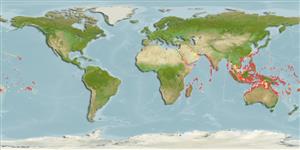Common names from other countries
>
Blenniiformes (Blennies) >
Blenniidae (Combtooth blennies) > Blenniinae
Etymology: Plagiotremus: Greek, plagios = oblique + Greek, trema = hole (Ref. 45335).
More on author: Bleeker.
Environment: milieu / climate zone / depth range / distribution range
Ecología
marino asociado a arrecife; rango de profundidad 1 - 40 m (Ref. 1602). Subtropical; 30°N - 30°S
Indo-Pacific: Red Sea south to Knysna, South Africa (Ref. 4404) and east to the Line, Marquesan and Society islands, north to southern Japan, south to Lord Howe Island. Replaced by Plagiotremus ewaensis in the Hawaiian Islands (Ref. 37816).
Tamaño / Peso / Age
Maturity: Lm ? range ? - ? cm
Max length : 12.0 cm SL macho / no sexado; (Ref. 559)
Short description
Claves de identificación | Morfología | Morfometría
Espinas dorsales (total) : 10 - 12; Radios blandos dorsales (total) : 31 - 37; Espinas anales: 2; Radios blandos anales: 29 - 33. Adults variable in color, ranging from black to yellow; 2 blue stripes on body (Ref. 4404, 48636).
Adults inhabit clear, coral-rich areas of lagoon and seaward reefs (Ref. 1602). They hide in deserted worm tubes or other small holes when alarmed (Ref. 1602, 48636), bite divers occassionally (Ref. 90102). They feed on the skin, mucus and sometimes scales of other fishes by quick attacks. Oviparous. Eggs are demersal and adhesive (Ref. 205), and are attached to the substrate via a filamentous, adhesive pad or pedestal (Ref. 94114). Larvae are planktonic, often found in shallow, coastal waters (Ref. 94114). Juveniles mimic the cleaner wrasse Labroides dimidiatus (Ref. 9710). According to Ref. 53299 they are facultative mimics that change their color: at cleaning stations they mimic the cleaner wrasse and attack unsuspecting customers; elsewhere they adopt an alternative color and striping pattern to conceal themselves among fish shoals from which they can strike at passing fish.
Life cycle and mating behavior
Maturities | Reproducción | Spawnings | Egg(s) | Fecundities | Larva
Oviparous, distinct pairing (Ref. 205).
Randall, J.E., G.R. Allen and R.C. Steene, 1990. Fishes of the Great Barrier Reef and Coral Sea. University of Hawaii Press, Honolulu, Hawaii. 506 p. (Ref. 2334)
IUCN Red List Status (Ref. 130435)
CITES (Ref. 128078)
Not Evaluated
Threat to humans
Harmless
Human uses
Pesquerías: comercial; Acuario: Comercial
Herramientas
Special reports
Download XML
Fuentes de Internet
Estimates based on models
Preferred temperature (Ref.
115969): 24.6 - 28.9, mean 27.6 (based on 650 cells).
Phylogenetic diversity index (Ref.
82804): PD
50 = 0.5005 [Uniqueness, from 0.5 = low to 2.0 = high].
Bayesian length-weight: a=0.00631 (0.00345 - 0.01155), b=3.14 (2.97 - 3.31), in cm Total Length, based on LWR estimates for this species & (Sub)family-body (Ref.
93245).
Nivel trófico (Ref.
69278): 4.5 ±0.80 se; based on food items.
Resiliencia (Ref.
120179): Alto, población duplicada en un tiempo mínimo inferior a 15 meses (Preliminary K or Fecundity.).
Fishing Vulnerability (Ref.
59153): Low vulnerability (10 of 100).
